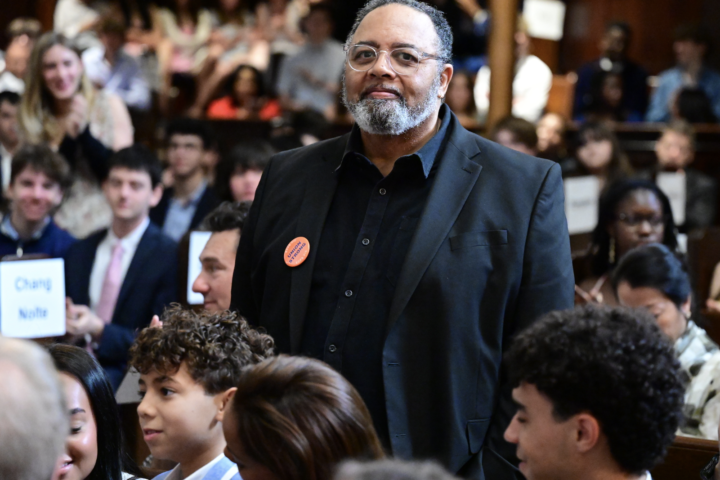
The Commons: a sanctuary for the introvert, the socialite, the band geek, the academic, the bake-seller. Its wood is eaten away by moisture and age and use, its ceiling arched in the most Hogwarts-esque manner that can be expected in a New York City school. It is the important, beautiful, gleaming, active, delightful, pulsing heart of Fieldston; it is a space for everyone and their everythings.
But for years, “everyone” has only been comprised of high schoolers.
That could all change with the upcoming plan to turn the Commons into a quasi-lunch space for the Middle School. The official jargon of choice for this new form of the Commons is “eatery,” though it is feasible that this new addition to the Commons’ functions will render its other functions useless, or at least partially so. The new glut of middle schoolers will no doubt crowd the Commons, making it difficult for high schoolers to conduct their own activities. While it has been guaranteed by the administration that the middle schoolers will only be in the Commons during a short period of designated time, one cannot help but imagine the possibility of early birds and stragglers. Even if this likely pattern does not reveal itself once the changes are made, it is impossible to overestimate the psychological effect of these changes. The Commons are the High School, for all its purposes and for all its students. Often, for all its faculty. While the Middle School occasionally invades the space, regularizing those invasions may destroy the sense of home that the Commons provides.
The main issue here is space. It is certainly a completely valid proposition from the standpoint of the middle school; trying to fit three hundred sixty tweens in a lunchroom is no small order. Staggering the lunches, with the aid of a new space, should solve that problem. (One could go with the Swiftian method, though that’s a thought for another day.) But there is, of course, the strain that would be put on the food service staff. Going back and forth from kitchen to Commons, all while managing the already busy cafeteria? Seems like a rather difficult task for a staff already spread thin by lunch periods spanning from nearly ten to two, not even including preparation and clean-up.
Given the long list of spatial changes that are set to occur over the next couple of years re the Master Plan, one cannot help but wonder whether funds would be best diverted from floating laboratories and Adler Labs to creating new dining space. Maybe they could even get some feedback from the people who attend, teach, and work at this school; day after day, and not in an ivory tower. But if the administration has no problem building large, unstable structures over parking lots, might I suggest the Middle School parking lot as a possible site for a levitating cafeteria? This sort of disregard of the student body and faculty is typical of the current administration. Sure, the Master Plan’s Disney-Clubhouse-ification of the Tate Library might be fine for a student body and faculty that does not care about reading. Sure, the Commons’ transformation into a Middle School eatery might be fine for a space that is not vital to a school’s community. Sure.
It has also come to my attention that a response article, written by student body president Jacob May, has emerged, one that suggests a misinterpretation of the facts regarding the Master Plan. According to this article, the Master Plan fully builds on the values of Fieldston, as described in the Strategic Plan. I have read the Strategic Plan, and besides being dense and bloated, it provides several great points. It certainly does not hide its efforts to build new spaces:
“Build science facilities on the Fieldston Upper and Lower
campuses that provide students with cutting-edge laboratory
and workshop space; are welcoming to visiting scientists,
engineers, and scholars; and alleviate cramped space.”
Where? Over parking lots seems like the current default solution. I am not denying that the Master Plan is built on the foundation that the Strategic Plan provides, but perhaps the Plans reflect a set of values that is not really well-researched, that is built on thin poles and filled with empty spaces. Sounds like a certain floating lab space I know about…but enough of that joke. Better sacrifice my own comfort for those who make this paper, and this school, respectable and viable. I, unlike a certain mustachioed gentleman I know of, can tell when something has worn out its welcome.
It is interesting that all the answers from the administration come in the form of a student-written article. It seems a bit…indirect? Distant? Removed? Huh, I guess all the best opinions of the administration are most accurately relayed through students. In an odd way, this sort of response is a wonderfully condensed version of the administration’s behavior, the reader’s digest version if you will: so neat and packaged, but without any substance. Maybe someone who is on the board or in the higher ups, someone who should be listening but could at least be talking, could provide a candid response.
Sort of like this one.







That said, until the 2006-2007 school year, Commons WAS the cafeteria (and the cafeteria was the “lower” gym). The Stu-Fac was the only lounge space on campus and all the 7th and 8th graders were crammed in as well (the 9th grade corridor was the middle school corridor — where were the freshmen? I have no idea). In other words, Commons has not been the “pulsing heart” of Fieldston for very long and it was a lovely, less congested cafeteria space only 8 short years ago.